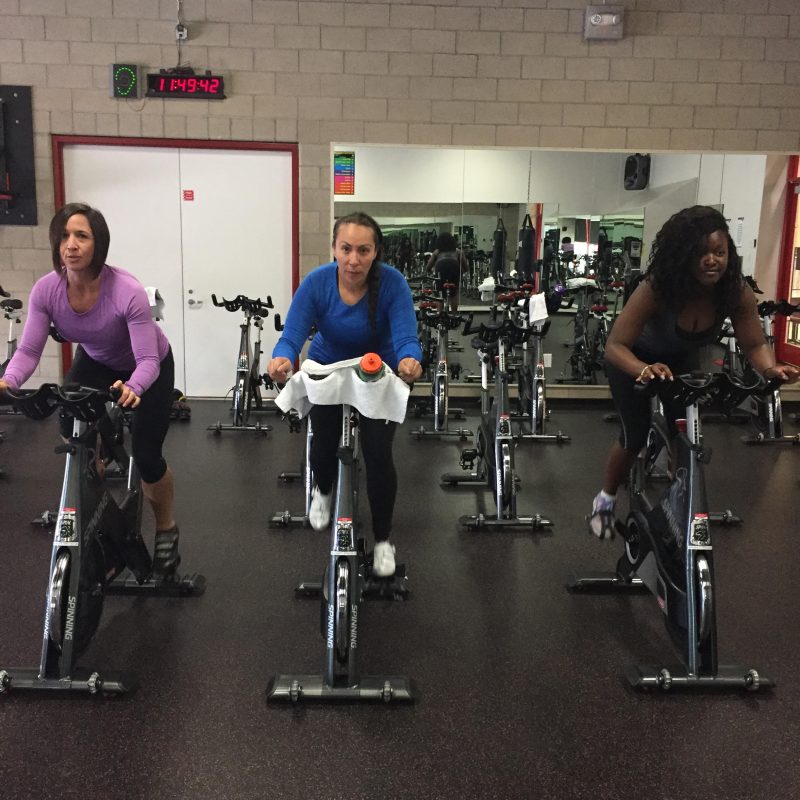
If the person next to you was jumping on a bike, would you? Even if jumps are contraindicated? But, what if they are actually beneficial? If your clients ride bikes or attends indoor cycling classes, then it’s important to know the pros, cons and proper technique of this popular move. As you know, what your clients do when they aren’t with you, impacts what happens when they are training with you.
In April I discussed modifications for contraindicated movements in indoor cycling classes. One of the movements that I addressed turned out to be a bit of a touchy subject: jumps.
You Jump. I jump.
It seems that when it comes to jumps, there are two camps: Those whose certifications support jumps as one of the five core movements of Spinning, and those who believe that jumping presents some contraindications.
I did a bit more research and consulted with instructors who say, “ jump,” about the physiological benefits and proper techniques to share with clients.
What a jump is NOT
To begin, a clear distinction between jumps and their newest adaptations, popcorn jumps and tap backs, must be made.
Tap backs, which often have very light resistance, require riders to begin in a standing position, quickly tap the glutes toward the saddle, and return to standing position immediately.
Pop corn jumps are a rapid, low resistance in-and-out of the saddle jump that lacks proper support for the knees and lower back.
Published research on the physiological benefits of these jump variations has yet to be seen. To learn about about their contraindications, check out my blog 4 Contraindicated Cycling Exercises with Modifications.
What a jump IS
A jump is a smooth surge in-and-out of the saddle that simulates a road cyclists need to increase power to get up a hill, a switchback, or break away from the pack.
Is it safe to jump?
Jumps, depending on the resistance, speed (RPM), and form have been identified as not only safe, but advantageous for both muscular and cardiovascular endurance.
Jumps, if executed correctly, can be a great way for the body develop stability and efficiency because they challenge riders to adapt to varied demands while maintaining smooth transitions.
Jump Form
Spinning Master Instructor Jeff Krabiel says that forward flexion does not increase and cadence remains consistent (ideally) during transitions.
Riders should spend a few seconds in the saddle before transitioning from hand position 2 seated to position 3 standing. Equal amount of time should be spent out of the saddle followed by a soft return.
Pace and Duration
Terrain, or resistance rather, will determine appropriate speeds to jump. If the resistance mimics a hill, 60-80 RPM is recommended. Flat road jumps may be cued from 80-110, but a safe recommended RPM is below 90.
20-30 second blocks of jumps every 30-60 seconds is the suggested time frame by Master Trainer, Jennifer Sage.
It is recommended that counts of 4, 8, 16, and even 32 be cued for in-and-out of the saddle transitions.
Jump Cues
Since many of the personal trainers at my gym have clients who use the indoor cycling bikes on their own, I gathered some useful tools for them to pass along to their clients. Ideas that you can use too!
The following cues were the input of about 15 other cycling instructors:
- Use the legs to lift in and out of the saddle
- Smooth transitions with hands from seated 2 to standing 3
- Keep grip light to prevent pulling yourself out of the saddle
- Take gentle seats to avoid slamming down
- Count: up 2, 3, 4, down 2, 3, 4 or use music that has a particular lyric or verse that can be a helpful auditory cue to move in and out of the saddle.
Special thanks to Hollie Pierce, Katelyn Merrill, Rhonda Jones, and Jennifer Sage for you support and valuable feedback on this topic.
[info type=”facebook”]What useful cues do you recommend for your clients? If you’re an NFPT trainer, join the Facebook Community Group to keep this discussion going and if you’re not, come chat with NFPT here![/info]
References
https://www.indoorcyclingassociation.com/to-jump-or-not-to-jump/
http://spinlife.spinning.com/to-jump-or-not-to-jumps/






